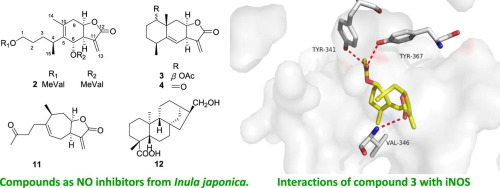Bioorganic Chemistry ( IF 5.1 ) Pub Date : 2018-01-04 , DOI: 10.1016/j.bioorg.2018.01.009 Feng Liu , Bangjian Dong , Xueyuan Yang , Yuling Yang , Jie Zhang , Da-Qing Jin , Yasushi Ohizumi , Dongho Lee , Jing Xu , Yuanqiang Guo

|
The extensive pathology studies revealed that Alzheimer’s disease (AD) is closely related to neuroinflammation and anti-neuroinflammatory agents may be potentially useful for the treatment of AD. Inula japonica is a member of the Asteraceae plant family and its flowers have been used as a healthy tea and a traditional Chinese medicine. Our continuous search for new nitric oxide (NO) inhibitory substances as anti-neuroinflammatory agents for AD resulted in the isolation of two new sesquiterpenes and ten known terpenes from the flowers of I. japonica. Their structures were established on the basis of extensive analysis of NMR and MS spectroscopic data, as well as calculated and experimental electronic circular dichroism (ECD) spectra. Among these isolates, compound 1 is a new sesquiterpene with a rare tricyclic fused skeleton, and 2 processes a 1,10-seco-eudesmane skeleton. The anti-neuroinflammatory effects were examined by inhibiting NO release in LPS-induced murine microglial BV-2 cells. The possible mechanism of NO inhibition was also investigated using molecular docking, which revealed the interactions of bioactive compounds with the iNOS protein. The present study disclosed that the flowers of I. japonica as a healthy tea are potentially useful for AD and related neuroinflammatory diseases.
中文翻译:

NO抑制剂可作为日本菊旋花的潜在抗神经炎药
广泛的病理学研究表明,阿尔茨海默氏病(AD)与神经炎症密切相关,抗神经炎药可能对治疗AD有潜在的帮助。日本的Inula japonica是菊科植物家族的一员,其花朵已被用作健康茶和传统中药。我们不断寻找新的一氧化氮(NO)抑制物质作为AD的抗神经炎药,导致从粳稻的花中分离出两种新的倍半萜和十种已知的萜烯。在广泛分析NMR和MS光谱数据以及计算和实验的电子圆二色性(ECD)光谱的基础上,确定了它们的结构。在这些分离物中,化合物1是一种新的倍半萜,具有罕见的三环稠合骨架,由2个组成1,1- seco -eudesmane骨架。通过抑制LPS诱导的鼠小神经胶质BV-2细胞中NO的释放来检查抗神经炎作用。还使用分子对接研究了NO抑制的可能机制,这揭示了生物活性化合物与iNOS蛋白的相互作用。本研究表明,作为健康茶的日本粳稻花可潜在用于AD和相关的神经炎性疾病。


























 京公网安备 11010802027423号
京公网安备 11010802027423号